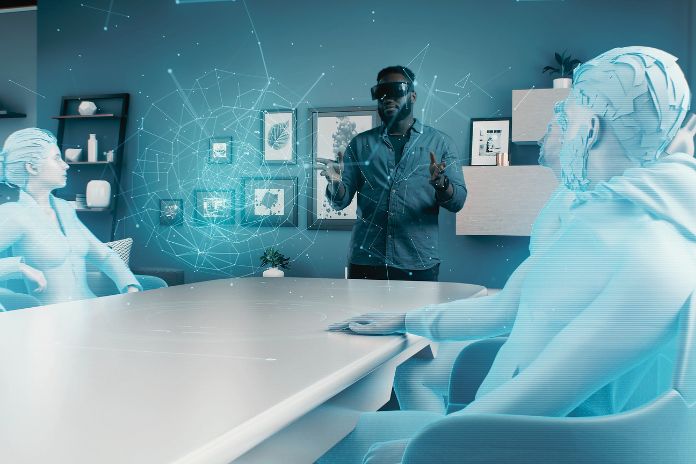Virtual Reality: With advances in immersive technologies and increasing consumer familiarity, the time is right for companies to use virtual reality.
After all, with the help of equipment such as headphones, glasses, portable devices, and wearables, it is possible to offer memorable sensory experiences for both internal and external audiences.
Many leading brands are already implementing the technology, known as VR to boost digital marketing efforts. In the coming years, the sectors that should invest the most are automotive, technology and telecommunication, retail, and health services.
In this post, check out the benefits of using this technology in your company and how the market is taking advantage of it.
Benefits Of Using Virtual Reality For Companies
If you need good reasons to convince yourself that investing in this resource is a good idea, check out the three benefits we separate below.
Optimizes The Customer Experience
The most exciting impact of virtual reality is on the customer experience. Thanks to technology, customers visit digital showrooms, interact with sales assistants, and virtually experience products and services. Examples of this are available worldwide, with more retail-oriented technology always hitting shelves.
Increases People Engagement
The average consumer is more informed, often with an endless supply of potential options just a tap away from the mobile app. He receives various sales information at all times. In this scenario, virtual reality allows people to touch the options with their hands instead of just seeing them, which improves engagement and the power of autonomy in decisions.
Facilitates Immersive And Interactive Marketing Strategies
VR technology allows companies to use the “try before you buy” concept. With it, product marketing revolves around creating a first-hand immersive experience, as it can transport people to any place, whether real or imaginary. This technology transforms the logic of marketing, which goes from telling the story of a product to offering experimentation.
Ways To Use Virtual Reality In Organizations
There are many ways to use VR in business, and now let’s explore a few. Check out!
Meetings
Imagine being miles away from your colleagues or clients but physically inhabiting the same meeting room and office space. Virtual reality helps to catalyze this experience. When the user puts on the glasses and noise-canceling headphones, they enter an immersive and collaborative virtual environment.
For example, the sensors implemented in the Oculus Rift pick up and translate body language and other non-verbal communication that would be lost with traditional teleconferencing or Skype. Language barriers are also eliminated as these apps can translate in real time.
Gamification
It may seem strange, but mixing work and fun is a good thing. Gamification uses game elements such as competition, points, and limited rules to engage participants in performing tasks. It is used by large companies such as Microsoft and Deloitte to make teams more productive and proactive.
The first used technology to turn native-speaking contributors into software language localizers. Through a simple app, viewers check different parts of a show for translation errors. They found that much of the program’s content was linguistically correct and made adjustments based on user feedback.
Corporate Mobility
Today, a significant part of the workforce is made up of millennials. People in this generation seek a high degree of flexibility, mobility, and, generally, an emphasis on work-life balance. As with artificial intelligence, VR and AR (augmented reality) technologies are allied with corporate mobility and help the HR department in many ways to meet these demands.
For example, the apps allow employees to achieve their desired mobility by virtually accessing office space. How about using VR to help potential candidates make better decisions? In this way, it is possible to show the day-to-day in the company or experience a tour of the internal sectors. Ultimately, this facility can increase retention rates and decrease staff turnover.
Prototyping And Design
A few decades ago, product development from concept to launch was extremely expensive, time-consuming, and risky. Technological advances have changed this reality. Now, we have great skills to create low-cost prototypes to test something before we release it to the market.
VR favors prototyping, perfecting the approaches and tools needed to implement ideas. With technology, it is possible to expand the possibilities of experiments without the high expenses involved in direct production. So, instead of wasting time and money without a 100% guarantee of the desired results, you explore potential problems and then build to perfection.
Training
Customer service training, for example, requires employees to be taught how to impact, retain and understand customer satisfaction and how to use greetings, body language, appropriate tone of voice, and how to handle complaints best.
These skill sets can be quite difficult to hone if learning is hypothetical. With virtual reality, however, employers can simulate real life, exposing employees to situations such as dealing with customer dissatisfaction or delivering strategies that make the customer happier.
Product Demos
VR product demonstrations promote consumer interaction with the product in a persuasive virtual environment by presenting parts, features, colors, and assembly. At conferences and trade shows, technology helps create experiences that are engaging, cost-effective, and easily portable. Rather than spending money on big stages or hauling complete product lines, companies immerse attendees in an immersive, highly realistic experience.
Retail
Retail offers some of the most explicit commercial applications for VR. Virtual reality heat mapping technology tracks a shopper’s gaze in brick-and-mortar stores, providing a detailed pattern of which areas or products attract the most attention. This allows retailers to test and refine store displays, signage, and layout to maximize the consumer experience and spending.
E-commerce
VR revolutionizes the e-commerce sector, contributing to decreased product returns, and has significant potential in the travel, hospitality, design, education, engineering, and health segments. Technology offers a real taste of potential destinations and hotel facilities in the travel business. So connected shoppers experience a complete retail environment in their breakout space.
Also Read: Recognize The Importance Of Social Media For Your Business

